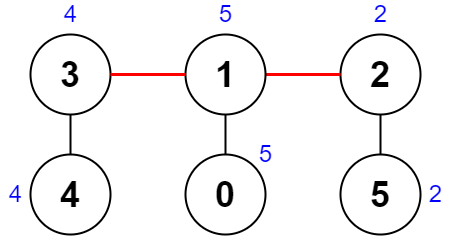LeetCode in Kotlin
2322. Minimum Score After Removals on a Tree
Hard
There is an undirected connected tree with n nodes labeled from 0 to n - 1 and n - 1 edges.
You are given a 0-indexed integer array nums of length n where nums[i] represents the value of the ith node. You are also given a 2D integer array edges of length n - 1 where edges[i] = [ai, bi] indicates that there is an edge between nodes ai and bi in the tree.
Remove two distinct edges of the tree to form three connected components. For a pair of removed edges, the following steps are defined:
- Get the XOR of all the values of the nodes for each of the three components respectively.
- The difference between the largest XOR value and the smallest XOR value is the score of the pair.
- For example, say the three components have the node values:
[4,5,7],[1,9], and[3,3,3]. The three XOR values are4 ^ 5 ^ 7 = **6**,1 ^ 9 = **8**, and3 ^ 3 ^ 3 = **3**. The largest XOR value is8and the smallest XOR value is3. The score is then8 - 3 = 5.
Return the minimum score of any possible pair of edge removals on the given tree.
Example 1:

Input: nums = [1,5,5,4,11], edges = [[0,1],[1,2],[1,3],[3,4]]
Output: 9
Explanation: The diagram above shows a way to make a pair of removals.
-
The 1st component has nodes [1,3,4] with values [5,4,11]. Its XOR value is 5 ^ 4 ^ 11 = 10.
-
The 2nd component has node [0] with value [1]. Its XOR value is 1 = 1.
-
The 3rd component has node [2] with value [5]. Its XOR value is 5 = 5.
The score is the difference between the largest and smallest XOR value which is 10 - 1 = 9.
It can be shown that no other pair of removals will obtain a smaller score than 9.
Example 2:

Input: nums = [5,5,2,4,4,2], edges = [[0,1],[1,2],[5,2],[4,3],[1,3]]
Output: 0
Explanation: The diagram above shows a way to make a pair of removals.
-
The 1st component has nodes [3,4] with values [4,4]. Its XOR value is 4 ^ 4 = 0.
-
The 2nd component has nodes [1,0] with values [5,5]. Its XOR value is 5 ^ 5 = 0.
-
The 3rd component has nodes [2,5] with values [2,2]. Its XOR value is 2 ^ 2 = 0.
The score is the difference between the largest and smallest XOR value which is 0 - 0 = 0.
We cannot obtain a smaller score than 0.
Constraints:
n == nums.length3 <= n <= 10001 <= nums[i] <= 108edges.length == n - 1edges[i].length == 20 <= ai, bi < nai != biedgesrepresents a valid tree.
Solution
class Solution {
private var ans = Int.MAX_VALUE
// function to travel 2nd time on the tree and find the second edge to be removed
private fun helper(
src: Int,
graph: Array<ArrayList<Int>?>,
arr: IntArray,
par: Int,
block: Int,
xor1: Int,
tot: Int,
): Int {
// Setting the value for the current subtree's XOR value
var myXOR = arr[src]
for (nbr in graph[src]!!) {
// If the current nbr is niether the parent of this node nor the blocked node , then
// only we'll proceed
if (nbr != par && nbr != block) {
val nbrXOR = helper(nbr, graph, arr, src, block, xor1, tot)
// 'src <----> nbr' is the second edge to be removed
// Getting the XOR value of the current neighbor
// The XOR of the remaining component
val xor3 = tot xor xor1 xor nbrXOR
// Getting the minimum of the three values
val max = xor1.coerceAtLeast(nbrXOR.coerceAtLeast(xor3))
// Getting the maximum of the three value
val min = xor1.coerceAtMost(nbrXOR.coerceAtMost(xor3))
ans = ans.coerceAtMost(max - min)
// Including the neighbour subtree's XOR value in the XOR value of the subtree
// rooted at src node
myXOR = myXOR xor nbrXOR
}
}
// Returing the XOR value of the current subtree rooted at the src node
return myXOR
}
// function to travel 1st time on the tree and find the first edge to be removed and
// then block the node at which the edge ends to avoid selecting the same node again
private fun dfs(src: Int, graph: Array<ArrayList<Int>?>, arr: IntArray, par: Int, tot: Int): Int {
// Setting the value for the current subtree's XOR value
var myXOR = arr[src]
for (nbr in graph[src]!!) {
// If the current nbr is not the parent of this node, then only we'll proceed
if (nbr != par) {
// After selecting 'src <----> nbr' as the first edge, we block 'nbr' node and then
// make a call to try all the second edges
val nbrXOR = dfs(nbr, graph, arr, src, tot)
// Calling the helper to find the try all the second edges after blocking the
// current node
helper(0, graph, arr, -1, nbr, nbrXOR, tot)
// Including the neighbour subtree's XOR value in the XOR value of the subtree
// rooted at src node
myXOR = myXOR xor nbrXOR
}
}
// Returing the XOR value of the current subtree rooted at the src node
return myXOR
}
fun minimumScore(arr: IntArray, edges: Array<IntArray>): Int {
val n = arr.size
val graph: Array<ArrayList<Int>?> = arrayOfNulls(n)
var tot = 0
for (i in 0 until n) {
// Initializing the graph and finding the total XOR
graph[i] = ArrayList()
tot = tot xor arr[i]
}
for (edge in edges) {
// adding the edges
val u = edge[0]
val v = edge[1]
graph[u]!!.add(v)
graph[v]!!.add(u)
}
ans = Int.MAX_VALUE
dfs(0, graph, arr, -1, tot)
return ans
}
}

